Learning about a trade can be a daunting process, and sometimes even the most seasoned need a reminded on all the tools for the trade. In this article I’ll be going over the different types of drill bits available on the market today. I’ll also be touching on which types of drill bits you’ll want to use for specific materials such as wood, metal and masonry.
You can probably guess the difference between a screwdriver bit and a drill bit but what about the difference between a Scrulox bit and a JIS bit? My goal is to have you leave this article knowing a little bit more than you did before you came.
You may think it’s a load of old Scrulox but choosing the wrong bit could spell disaster for your job and could even damage your precious tools. To make sure you get it right we’re going to go over a few common (and not so common) bit types and give you all the information you need to make the right choice.
Here’s a List of the Different types of Drill Bit
Drill bits will usually always make a hole in something but the way they do it and the material they do it in will be very different.
HSS Bit – Explained

These are the things you first think of when someone says, “drill bit”.
They are typically made from High Speed Steel (HSS) and will drill through wood, light metals, fibreglass, and PVC without much hassle. They will usually have a cylindrical shank, but you can also get them with a ¼” hex shank.
Masonry Bit – Explained

Tungsten Carbide tipped masonry bits are designed to smash through bricks, concrete, and stone while leaving a nice neat hole. They achieve this with their hammer like tip made from the incredibly strong Tungsten Carbide.
You will usually see these bits with a smooth shank but, in higher end sets, these bits will have a hexagonal shank to stop the bit from slipping out of your drills chuck when the bit is under substantial load.
Josh Says: Masonry bits heat up rapidly during use and this heat can actually melt the tungsten brazing on the tip. Best practice is to withdraw the bit regularly to clean its flutes and make sure your drill is set to the proper speed.
Flat Bit – Explained
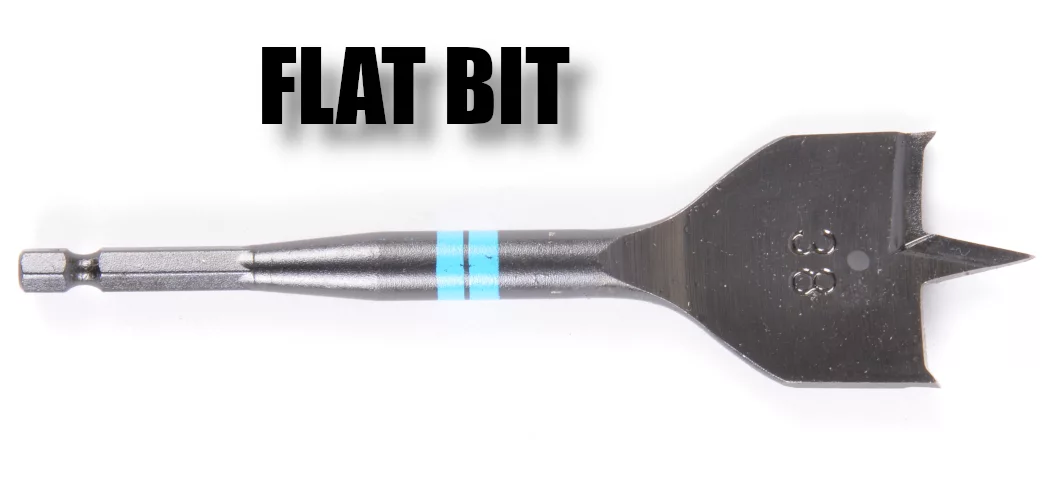
Sometimes referred to as a “spade bit” or even a “speed bit”. These are very interesting looking bits that are designed to make holes in wood as quickly as possible.
The design varies from manufacturer to manufacturer, but the standard shape will have a point in the middle to give you your pilot hole and then two “wings” that come out to the side and its these bits that do the hard cutting work.
These bits are designed to make many holes very quickly, so they are not the greatest if you are trying to make neat and tidy holes. If hole condition is forefront in your mind then you might be better off reading on.
Augur Bit – Explained

Auger bits are capable of drilling large holes into thick timber with ease.
The screw thread at the tip draws the bit into the material while the single spur scribes the circumference of the hole into the timber before the flute gets there to actually make the cut.
This gives you a much cleaner finish than a spade bit but the trade off is that the auger is usually a lot slower.
Multipurpose Bit – Explained
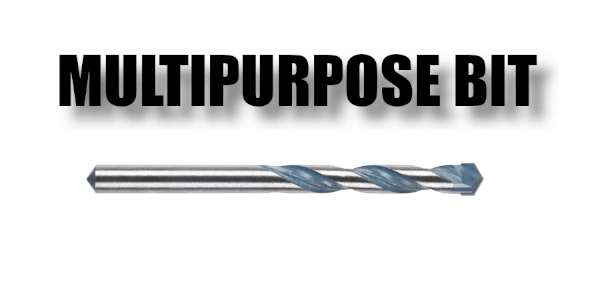
As the name suggest, these bits have a special diamond ground tungsten carbide tip that can get through nearly every type of material including wood, masonry, ceramics, plastic, and metal.
Josh Says: While these bits CAN get through masonry it is advisable to only use them in rotary mode as repetitive masonry hammer drilling can damage the tip in the long run.
If you’re just going to be drilling masonry all day, then it’s best to go for some proper masonry bits.
Titanium HSS Bit – Explained
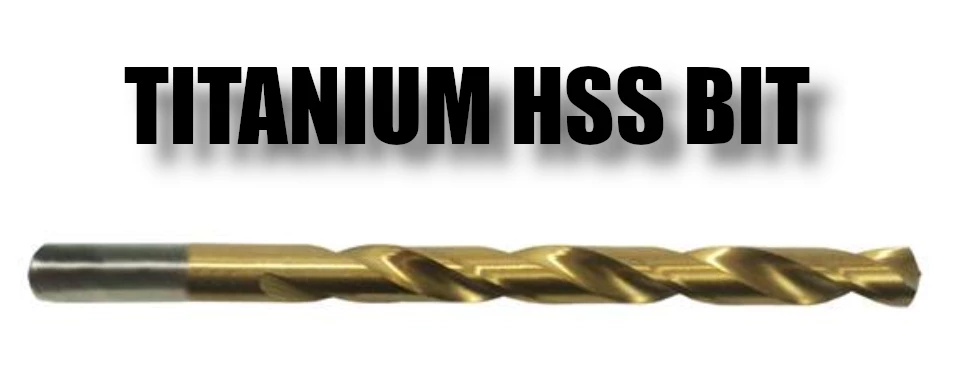
These bits are very interesting because the Titanium coating can extend the life of the bit by up to 5 times! They do this by reducing and heat build up and increasing the bits lubricity. They work exactly like an HSS bit and will go through the same material without any hassle.
Cobalt HSS Bit – Explained

These are another HSS bit, but they are precision ground from solid cobalt alloyed high speed steel. This gives them a very high resistance to high temperatures and abrasion, making them ideal for drilling high tensile steels, including cast iron, stainless steel, and weld seams.
Forstner Bit – Explained
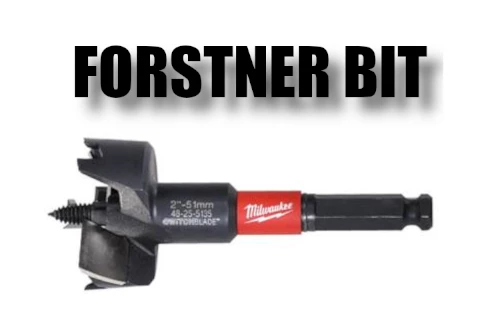
The forstner bit is not something you will come across every day, but it is very handy if you want to make a large diameter hole with a flat bottom, like you would if you were installing concealed hinges.
There are two types of forstner bit – continuous rim (as below) and saw rim. Continuous rim leaves a very clean edge and is best for smaller diameters whereas the saw rim is best for bigger diameters but does not leave as clean of a cut.
Josh Says: Don’t try and use one of these with your £30 plastic drill. They need serious torque and a lot of forward pressure to operate. You will need a high-powered drill or a drill press to use these properly.
Countersinks – Explained
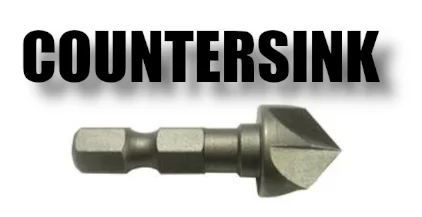
A countersink bit is used to create an opening at the top of a pilot hole so a screw can sit flush against the material. They are a very simple bit and can be used with nearly every drill without much of a headache.
Drill/Countersink Bit – Explained
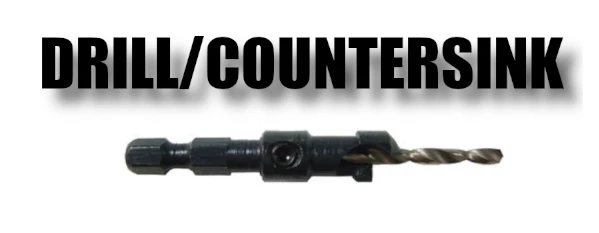
A Drill/Countersink bit is exactly what the name suggests, an HSS drill bit and a countersink together.
With this bit you can drill your pilot hole and countersink the top all with the same movement. The HSS bit is secured with a grub screw and can be adjusted depending on how deep you want your pilot hole.
Self Centring Bit – Explained
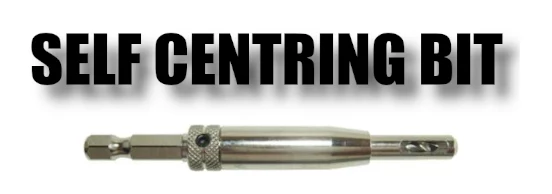
Self-Centring bits (Sometimes referred to as “Vix Bits”) are designed to drill very accurate pilot holes in hinges, brackets, and other such hardware.
The tip of the bit will sit happily in the countersunk holes and will automatically align itself to the centre. As you push down, the spring-loaded bit is pushed out of its metal sleeve and drills into the work, leaving you with a perfectly centred pilot hole.
The internal HSS bit can also be adjusted or removed via a small grub screw on the side.
SDS+ Bit – Explained

SDS+ Bits are a little bit different that the bits we’ve seen so far in that you need a special type of drill to use them.
And SDS+ bit has two grooves along its side which the SDS+ drill will lock into and its these grooves that allow the bit to move back and forward in the chuck to generate an extremely powerful hammer action.
These bits are designed to drill and break through very tough masonry work and its not recommended that you use them for anything else.
SDS Max Bit – Explained
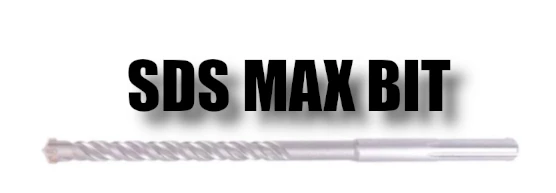
SDS MAX Bits are simply the bigger brother of the SDS+ Bit.
They have a much thicker shank and an additional anchor point for the SDS MAX drill to clamp on to and force the bit through some of the toughest materials around.
SDS+ and SDS MAX bits, chucks, and drills are not interchangeable.
Step Drill Bit – Explained

Step Drills are conical shapes bits that allow you to increase the diameter of existing holes in light materials and for light deburring.
The good thing about Step Drills is that you only usually have to buy one because they are designed in a way that will give you a lot of different sizes from the same bit.
Step Drills are usually coated in titanium-nitride as they do generate a lot of friction heat when in use.
Saw Bit – Explained
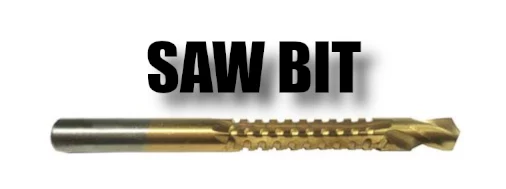
A Saw Bit is another piece that you won’t see everyday, but they are incredibly handy to have around.
They start out like your typical HSS bit but, as you get further along the shaft, the pattern changes to something a lot more abrasive.
If you carefully apply lateral force to the bit, this abrasive pattern can be used to saw holes into the wood or metal.
Josh Says: Be careful applying lateral force to the bit as all drill bits are designed to be strongest with forward pressure.
Also, be aware that these bits can be difficult to steer when applying lateral force, so you may not end up with as clean a hole as you’d like unless you are especially careful.
Plug Cutter – Explained

A plug cutting bit does what it says on the tin really, it cuts plugs. But what are plugs?
Plugs are little cylindrical pieces of wood that you insert into a countersunk screw cavity to hide the screw. You can either match the grain as best you can to really minimise the appearance of the plug or you can also use different types of wood to create contrasting colours on your piece.
Josh Says: Plug Cutters do not have a centre point to keep them steady and aligned so it is recommended that you only use these in a drill press
So that covers the majority of drill bit types that you are likely to encounter. We made the decision to omit Hole Saws from this list because, as there is such a wide variety of them, it would be better to give them their own post.
It would be a monumental if not impossible task to sit here and list off the countless types of drill and screwdriver bit that people use across the world. In fact, as you’re reading this, someone somewhere has come up with a new one and rendered a “list of every bit” completely pointless.
What we’ve done here instead is give you some information you may not have known about bits you use every day and some more information about bits you’re perhaps seeing for the first time today.
We hope you have learned a thing or two while reading this and if you ever come across a weird and/or wonderful bit please feel free to tell us about it in the comments below!


thank you for making this article very useful and keep up the good work
I found your guide on the different types of drill bits incredibly insightful. I was particularly intrigued by the Plug Cutter, which is used to cut plugs to hide screws. Given that it doesn’t have a center point for stability, do you have any tips or techniques for those who might not have a drill press but still want to use a plug cutter effectively